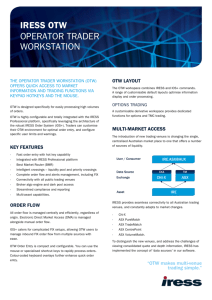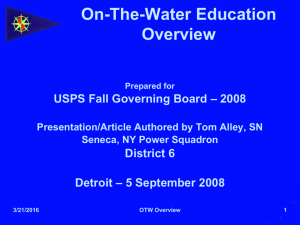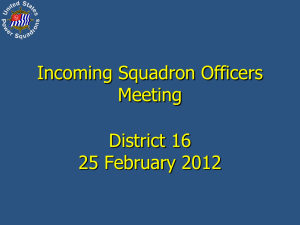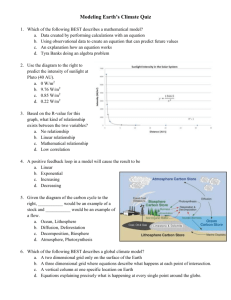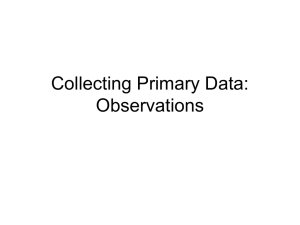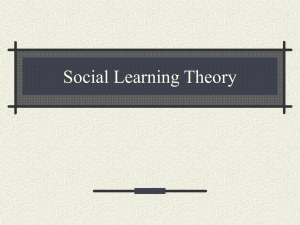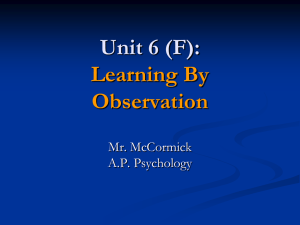Evidence of Learning - Observations, Grades 1
advertisement
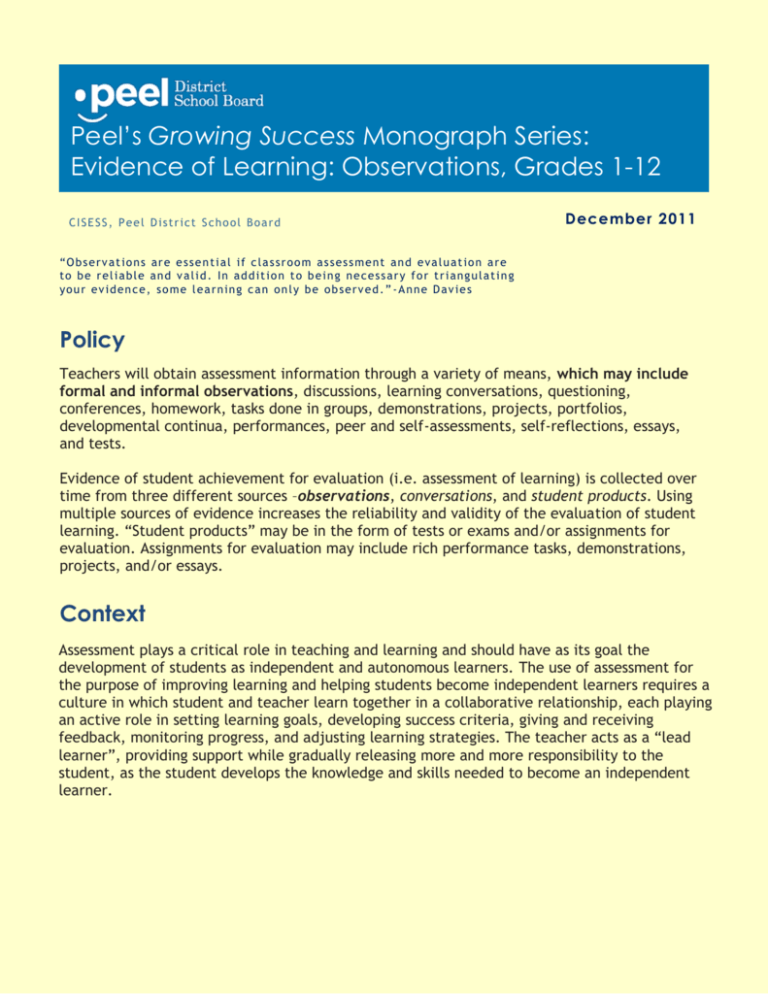
Peel’s Growing Success Monograph Series: Evidence of Learning: Observations, Grades 1-12 CISESS, Peel District School Board December 2011 “Observations are essential if classroom assessment and evaluation are to be reliable and valid. In addition to being necessary for triangulating your evidence, some learning can only be observed.” -Anne Davies Policy Teachers will obtain assessment information through a variety of means, which may include formal and informal observations, discussions, learning conversations, questioning, conferences, homework, tasks done in groups, demonstrations, projects, portfolios, developmental continua, performances, peer and self-assessments, self-reflections, essays, and tests. Evidence of student achievement for evaluation (i.e. assessment of learning) is collected over time from three different sources –observations, conversations, and student products. Using multiple sources of evidence increases the reliability and validity of the evaluation of student learning. “Student products” may be in the form of tests or exams and/or assignments for evaluation. Assignments for evaluation may include rich performance tasks, demonstrations, projects, and/or essays. Context Assessment plays a critical role in teaching and learning and should have as its goal the development of students as independent and autonomous learners. The use of assessment for the purpose of improving learning and helping students become independent learners requires a culture in which student and teacher learn together in a collaborative relationship, each playing an active role in setting learning goals, developing success criteria, giving and receiving feedback, monitoring progress, and adjusting learning strategies. The teacher acts as a “lead learner”, providing support while gradually releasing more and more responsibility to the student, as the student develops the knowledge and skills needed to become an independent learner. Page 2 Evidence of Learning: Observations 1-12 What is observational evidence? Evidence of learning refers to anything that students do, say or create that demonstrates understanding of Ontario curriculum expectations. Evidence of learning also refers to a more holistic approach or process of appraising what students know, can do and understand in place traditional assessment methods of teaching, quizzing and testing. It uses the process of triangulation of student data used in research to provide a more well-rounded and all-inclusive picture of student achievement. Triangulation means collecting student evidence over time from three sources: observations, conversations and student products and considering all three sources in determining students’ grades. Using observation is a powerful way of deepening our understanding about the quality of student learning. Teachers can use this evidence to inform their professional judgement, along with other forms of evidence, when determining students’ grades. The key is to be clear with students about what you’re looking for and to find an efficient way to track/record your observations. In purposeful observation, teachers assume the role of professional witness to learning and use this information to more fully understand the learning process and as a third point of reflection about teaching practice. How Does Observational Evidence Align to Growing Success Policy? (Assessment Framework: Processes and Strategies in a Collaborative Relationship for Teachers, Peers, and Individual Learners) Page 3 Evidence of Learning: Observations 1-12 How Might I Think About Student Observation Before, During and After Learning? Before: What is the teaching context for the observation? (what part of learning cycle?) How will I create a positive and supportive learning climate? What am I looking for exactly? When will I start? How long will I observe? What do I communicate to students beforehand? (or not?) How will I record my observations in an efficient manner? (ticks, symbols, letters?) During: Will I interact with my students during the observation? If so, how and when? Will any feedback be provided during the observation? If so, how and when? How will technology be used to assist me in the observation? Describe the precise use. After: Is it appropriate to provide my students with feedback at this stage? If so, how? How might we debrief the learning as a class, in small groups, in a one-on-one conference? How might technology or online resources be used to debrief or enhance the observation? How Might I Go About Gathering Observational Evidence in My Classroom? Gathering Evidence from Observation Page 4 Evidence of Learning: Observations 1-12 Some Sample Observation Forms: Sample Teacher Observation Checklist (Generic) Student Name:____________________________ Date:__________________ Task:____________________________________________________________ Criteria (Look-fors) Yes Not Yet Teacher Comments Sample Teacher Observation Rating Scale (Frequency) Student Name:____________________________ Date:__________________ Task:____________________________________________________________ Criteria (Look-fors) All of the time Most of the time Some of the time Not very often Teacher Comments Sample Teacher Observation Rating Scale (Level of Quality) Student Name:____________________________ Date:__________________ Task:____________________________________________________________ Criteria Wow! Great Job! Getting Getting There! Started Teacher Comments Sample Teacher Observation Rating Scale (Learning Skills and Work Habits & Habits of Mind) Student Name:____________________________ Date:__________________ Learning Skill/Work Habit/Habit of Mind/Disposition:______________________________________ Sample Behaviours E G S N Teacher Comments Evidence of Learning: Observations 1-12 What Might Be Some Things I Might Consider As I Use Observational Evidence? Purpose of the Observation: (why are we doing this?) o For Learning (to promote learning?) o As Learning (to promote meta-cognition and self-assessment?) o Of Learning (to evaluate the quality of learning that has occurred?) Alignment of observational evidence look-fors, learning goals and success criteria? Student Readiness? (have students had time to learn/practice? Are they truly ready?) Safe and Supportive Classroom Climate? (are students made to feel comfortable in being the subjects of classroom observation? Are the lookfors framed in student-friendly language?) Logistical Concerns? (i.e., time of day, time of year, tracking sheets, media release forms) Equity and Cultural Proficiency Considerations in Observing Students? Success Criteria (do students know and truly understand all the “look-fors”?) Success Criteria/Look-fors, where appropriate (assessment of learning situations only), are delineated by four levels and connected to the appropriate achievement chart category(ies) Possible Observational Look-fors: o Discrete or transferable conceptual or procedural knowledge o Achievement Chart sub-skills o Discrete or transferable skills o Subject-specific vocabulary used correctly in context o Big ideas, enduring understandings, subject-specific processes o Habits of mind or dispositions o Learning skills and work habits o Other look-fors Page 5 Some Thoughts on the Value of Observational Evidence “Your own eyes and ears are your most important assessment tools! Trust them to help you identify students who need special consideration. The information you gather through observation will be invaluable, both to identify needy students and to plan to meet their needs. Your observations will also augment your written assessments when it is time to conduct them…”. -Damian Cooper “One of the most important responsibilities of a teacher is to observe students as they learn and to provide feedback about: what they are doing well what they are having difficulty with what steps they might take to improve. In this respect, the teacher’s role is similar to that of the coach observing an athlete. A coach would never attempt to quantify an athlete’s performance during practice, yet many teachers fall into the trap of quantifying everything that students do. Successful coaching and teaching involves feedback…”. “A teacher’s role when observing student performance is to exercise professional judgment in order to provide helpful feedback”. -Damian Cooper “Observations are essential if classroom assessment and evaluation are to be reliable and valid. In addition to being necessary for trian gulating your evidence, some learning can only be observed.” -Anne Davies Page 6 Evidence of Learning: Observations 1-12 What Might Be Some Things I Might Consider As I Use Observational Evidence? How many observations will be necessary to determine student mastery? How might I increase the number of observations for learning? Which variables might affect the overall quality of the observations? (i.e., age, grade, cognitive development, language development, context) Should it “be counted”? Tracking Forms for Recording the Evidence? (how can we keep the process simple?) Tracking Forms for Recording the Evidence? (symbols used to equate look-fors/targets?) How Might the Evidence Be Used to Improve Student Learning? Weight and Importance of This Evidence in Assigning/Determining Grades? (most consistent allowing for more recent evidence) Integration and Alignment of Observational Evidence with other Kinds of Evidence Gathered? What might be the patterns, trends, outliers found in the evidence? Level of teacher support allowed during the observational sequence over the term or semester using the gradual release model (explicit, shared, guided, independent)? Role of Peer and Self-assessment as another method for providing feedback? Role and Optimal Timing for Feedback? (descriptive and/or evaluative) Role of Assessment Tools and Strategies? Role of Established Cooperative Learning and/or Literacy Strategies/Structures? Student Voice and Involvement Before, During and After the Observation? Thoughtful, professional use of Electronic Grade book to capture observational data? Role of common sense and individual/collective professional judgement? Thoughtful use of technology to help capture or communicate evidence of learning (i.e. flip cameras, video cameras, audio-recording, voice-thread, web sites, co-teaching etc.) Re-culturing of parent and community understanding of concepts of evidence of learning and role of observational evidence in assigning and determining students’ grades? Level of administrator support in using observational evidence to inform and determine students’ grades? Available technologies which might be used within board guidelines and policy that would support gathering of observational evidence? Page 7 Evidence of Learning: Observations 1-12 How Might I Track Observations? (Sample Form) Grade/Class/Unit: Purpose of Observation: o Assessment for Learning? o Assessment of Learning? Unit/Task Learning Goals: Success Criteria /Look Fors & Equivalent Symbols for Notation: = = = Overall Assessment: Student B=Beginning--------OTW=On the Way-------M=Met Observation # 1 Observation # 2 Observation # 3 Date___________ Date___________ Date____________ Targeted Look-fors: Targeted Look-fors: Targeted Look-fors: 1. B OTW M B OTW M B OTW M 2. B OTW M B OTW M B OTW M 3. B OTW M B OTW M B OTW M 4. B OTW M B OTW M B OTW M 5. B OTW M B OTW M B OTW M 6. B OTW M B OTW M B OTW M 7. B OTW M B OTW M B OTW M 8. B OTW M B OTW M B OTW M 9. B OTW M B OTW M B OTW M 10. B OTW M B OTW M B OTW M Page 8 Evidence of Learning: Observations 1-12 An Additional Perspective: Persistent Observation - Definition "If the purpose of prolonged engagement is to render the inquirer open to the multiple influences - the mutual shapers and contextual factors - that impinge upon the phenomenon being studied, the purpose of persistent observation is to identify those characteristics and elements in the situation that are most relevant to the problem or issue being pursued and focusing on them in detail. If prolonged engagement provides scope, persistent observation provides depth" (Lincoln & Guba, 1985, p. 304). Triangulation Definition Triangulation involves using multiple data sources in an investigation to produce understanding. Some see triangulation as a method for corroborating findings and as a test for validity. This, however, is controversial. This assumes that a weakness in one method will be compensated for by another method, and that it is always possible to make sense between different accounts. This is unlikely. Rather than seeing triangulation as a method for validation or verification, qualitative researchers generally use this technique to ensure that an account is rich, robust, comprehensive and well-developed. Reasons to triangulate A single method can never adequately shed light on a phenomenon. Using multiple methods can help facilitate deeper understanding. (Lincoln & Guba, 1985, p. 304). Something to Think About… 1. Based on your experiences in observing students, what other guidelines or recommendations might you make about appropriate use of observational evidence? 2. In peer and self-assessment, what might be some effective strategies to get students to pay closer and more strict attention to the success criteria look-fors in their assessment in place of other considerations (i.e., social, peer group, convenience)? 3. What role might observational evidence play in the planning, assessment and evaluation framed within a collaborative inquiry (TLCP or PLC)? How might observation support teachers in becoming more adaptive, responsive and precise to meet students’ needs? 4. What might be some strategies that teachers can use to create/nurture a classroom climate that is safe, inclusive and equitable where observation is an effective tool? Additional Resources: Growing Success 2010: Assessment, Evaluation and Reporting in Ontario Schools, Covering Grades 1-12 Making Classroom Assessment Work, 2nd Edition, Anne Davies, Connections Group, 2007 Transforming Barriers to Assessment for Learning, Anne Davies, Sandra Herbst, Beth Parrot-Reynolds http://www.qualres.org/HomeTria-3692.html
